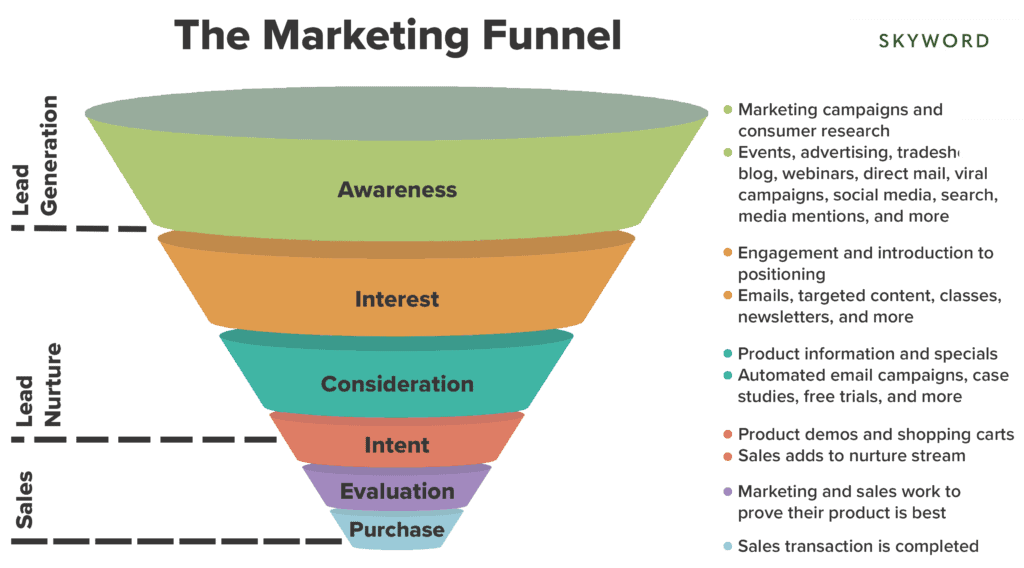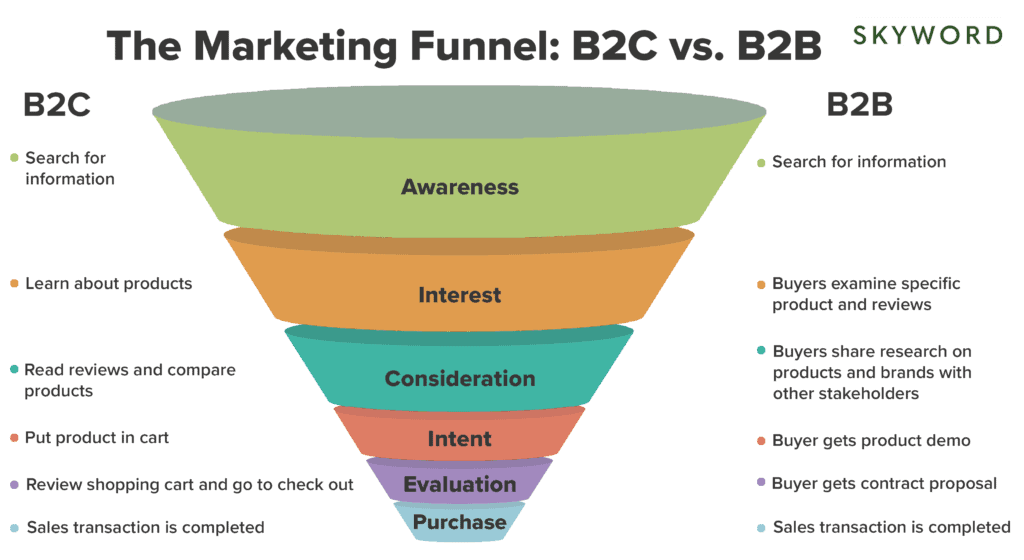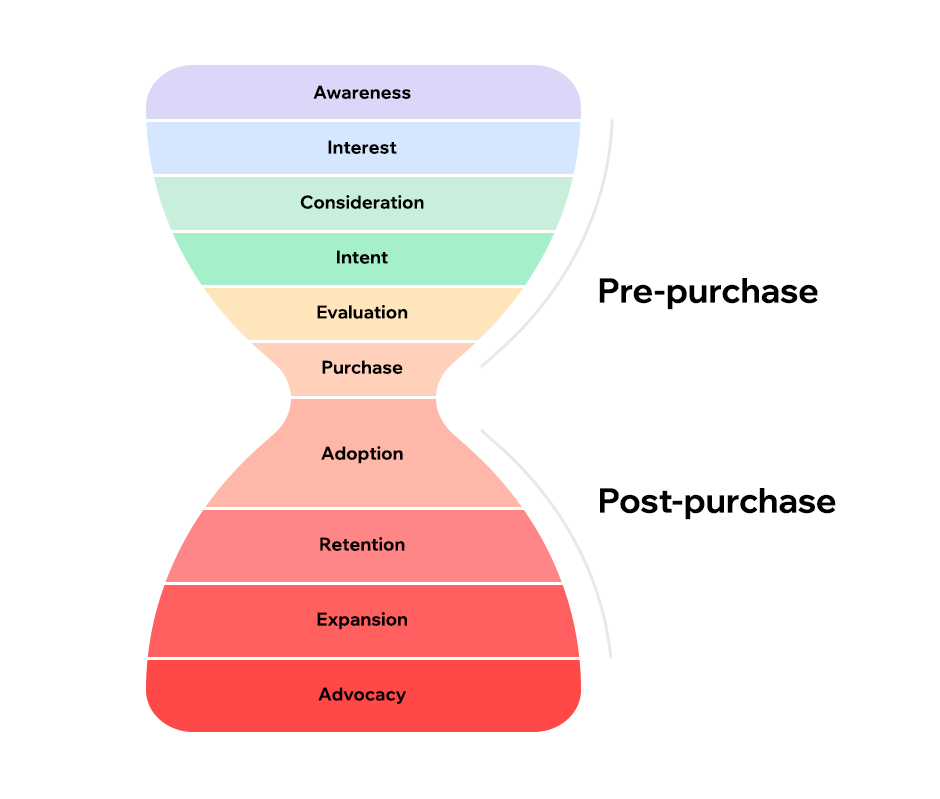“The customer is always right” This phrase may have started small as a department store’s slogan in the early 1900s, but it has developed into the motto of the society we live in. Even though you may have poured your heart and soul into launching a business and building a website to sell your services or goods, if the intended results are not achieved, the change should be on you, not your consumers.
In order to determine where consumers are losing interest in your offering, you must be able to recognize every pain point of the customer journey. Following that, you should modify your product in response to their feedback and determine whether the problem has been resolved. The marketing funnel will have all the resources you need to understand your customers better.
The marketing funnel, sometimes called the purchase funnel, is a diagram that illustrates all the steps a visitor must take before purchasing a good or service. Marketers should cast a wide net to gather as many leads as possible, then slowly nurture potential consumers through the buying process by narrowing down candidates at each level of the funnel.
The five stages that consumers go through prior to, during, and following a purchase were first described by American philosopher John Dewey in 1910. This concept eventually became the modern marketing funnel, emphasizing the various stages from when individuals learn about a company to when they purchase.
Getting consumers to buy immediately is not the goal of marketing campaigns. Instead, they begin by obtaining leads, or prospective buyers who have shown interest in the brand. Companies bring potential customers into the funnel by converting anonymous strangers into leads. They then continue to market to these leads in an effort to persuade some of them to make a purchase.

The top level of the marketing funnel is awareness. At this stage, customers discover your brand for the first time. Potential customers are attracted to this stage through marketing initiatives, consumer research, and discovery.
Events, advertisements, trade exhibits, content, webinars, direct mail, viral campaigns, social media, search, media mentions, and more are used to build trust. Here, lead generation occurs as information is gathered and leads are drawn further down the funnel.
Be careful to segment the market to build campaigns tailored to each customer type. In order to continue marketing to them, use lead capture forms to obtain their contact information. As you will be using their contact information to get in touch with them and direct them through the rest of the marketing funnel, this is one of the most crucial lead-generating tactics.
Following the generation of leads, they progress to the interest stage, where they learn more about the company, its offerings, and any useful data and research it may have. Brands have the chance to introduce their positioning and forge relationships with the individuals in their lead database at this time.
As companies begin to connect with all the contacts obtained during the previous step, lead generation transitions into lead nurturing at this point. Emails, more specialized information based on industries and brands, classes, newsletters, and other methods are all ways that marketers can nurture leads.
Email marketing is one of the best ways to generate interest. This enables you to contact leads directly with relevant, branded material and begin developing connections with them.
Leads are now considered marketing-qualified leads and are viewed as potential clients throughout the consideration stage. They are already aware of your product and are familiar with your brand at this point. Now it is up to you to persuade them that your product offers the greatest remedy for their issues.
Through automated email marketing, marketers may provide prospects with more details about their goods and promotions while also nurturing them with relevant content, case studies, free trials, and other things. Offering customers educational content, such as blog articles and webinars, that satisfies their needs while subtly pointing them in the direction of your product is another well-known funnel marketing strategy.
Prospects must show interest in a brand's goods before they can go on to the intent stage. This may occur when potential customers make it evident they want to buy a product by, for example, getting in touch with customer service, checking out a product demo, or adding a product to their shopping cart. This is a chance for marketers to convince customers that their product is the finest option available.
In light of this, the intent stage is the perfect opportunity to establish why your product or service is the best choice for the potential client. You must use persuasive marketing materials to convince them that your product is superior to those of your rivals.
Buyers are deciding definitively whether or not to purchase a brand's goods or services throughout the evaluation stage. In order to guide the decision-making process and persuade the customer that their brand's product is the best option, marketing and sales typically collaborate closely.
During this stage, marketing and sales teams must collaborate to persuade potential customers to make the purchase. The emphasis is maintained on positioning your company's offering as the best alternative, much as in the prior stage.
The last stage of the marketing funnel is where a prospect decides to buy and becomes a customer. This is where sales take care of the purchase transaction.
When customers have a favorable experience, they may recommend the business, which fills the top of the marketing funnel, and the cycle repeats. Utilize a variety of sales psychology strategies to understand your customer's mindset and close the transaction.

The number of people involved and the degree of engagement between businesses and customers are what distinguish the B2B and B2C marketing funnels from one another.
The majority of B2C customers move through the funnel on their own, having little to no direct contact with the company. B2C customers might never speak with a company representative directly, particularly on e-commerce websites. Few customers actually interact with a representative during outreach campaigns; instead, broad buying groups are targeted, or marketing automation techniques are used.
The buying group of B2B consumers is often bigger and cross-functional. The average B2B buying group is 5.4 people. The lower end of the marketing funnel is when B2B customers often connect with a sales professional, even though the higher stages of the funnel follow a similar pattern to those of B2C customers.
Several experts contend that the marketing funnel is no longer relevant because the purchase process is no longer linear. The funnel receives leads at various stages. They enter the intent stage sometimes because they are referred and are certain they want to purchase a brand's product.
It might occur as a result of their having pursued their own education and joining out of curiosity or consideration. Customers are increasingly conducting their own research and relying on digital content to educate them about products as a result of enhanced access to information brought about by technological advancements.

Many businesses are starting to abandon the conventional cone in favor of one that looks like a bowtie or hourglass. The few customers who made purchases and made it to the bottom of the conventional marketing funnel are where the upside-down cone shape begins. From then, firms consider the post-purchase customer experience while accounting for elements like customer satisfaction, endorsements, and feedback.
This new funnel strategy seeks to establish solid bonds with customers in order to keep them from switching to your rivals' offerings while also encouraging them to become steadfast supporters of your business.
Onboarding and installation take place during this phase. It's critical that a new customer may start using the service and realize benefits as soon as feasible after joining.
If the adoption process is too difficult or takes too long, it may make customers second-guess their choice, possibly resulting in churn. At this point, frequent examples include how-to manuals and tutorials, training materials, success checklists, and kick-off gatherings.
Businesses must ensure that consumers are successful and accomplish their goals with their product or service, effectively communicate this success internally, and always "feel the love" in order to maximize retention.
Genuineness is equally important. Customers should be able to tell that you actually care about them and want to see them succeed. This category includes programs for the customer community, educational content, best practices, product updates, vision and roadmap information, and certification programs.
Businesses are setting themselves up for customers to reciprocate the love in the expansion and advocacy stages the more they are able to provide value and demonstrate customer love in this stage.
The consumer is now prepared for an up-selling or cross-selling dialogue, whether it be add-ons, upgrades, extra users, other products/services, etc. if you were successful at each stage up to this point.
Customers will turn to you first to check whether you have a solution before turning to competitors if you have been truly successful at each level up to this point. The goal is to make it simple for customers to discover ways to expand their business with you and be ready to address their concerns and clearly explain the benefits of doing so.
The ultimate goal of the customer journey is advocacy. A brand advocate is an individual who uses a product or brand favorably and spreads favorable word-of-mouth advertising about it to other individuals. Numerous other people can be influenced by their recommendations and readiness to spread the word about your brand.
However, that is not the end. Once a customer endorses a brand, the goal is to keep them informed about the company's mission and goals while ensuring their continued happiness.
Advisory boards, exclusive advocate group memberships, communities for elite consumers, gifts, unique invites, and maintaining a strong personal relationship are all examples of special treatment that is frequently a good idea in this situation.
A marketing funnel is a fantastic tool for visualizing the buyer's journey or prospects' route as they learn more about your business and products, from awareness to purchase to the advocacy stage. Marketers will need to modify their marketing initiatives at each level in order to assist customers in progressing to the next. The ultimate objectives are to boost sales volume and value, raise brand awareness, and encourage referrals to fill the marketing funnel. Remember that this is a generic marketing funnel, so you may need to make some adjustments to make it work for your particular company.